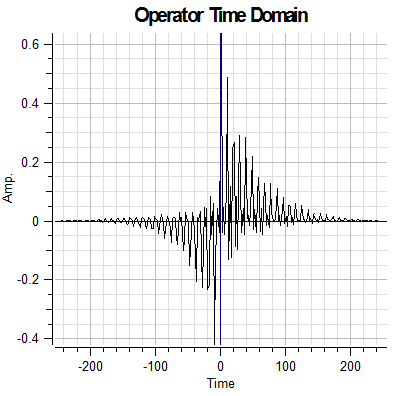This section describes how you can modify various parameters to design the deghosting operator.
The figure above shows the Design Controls dialog. This dialog allows the various parameters that control the operator to be varied.
To stabilise the deghosting operator, two sea surface reflectivity reflectivity parameters can be specified. One associated with the phase of the sea surface reflection, and the other the amplitude of the sea surface reflection. These can be adjusted to apply some damping and to avoid over-boosting signal and noise at the notch frequency.
The steps below give you a brief overview of the parameters found on the Design Controls dialog
Amplitude: The sea surface amplitude reflectivity coefficient. Controls the strength of the amplitude correction. Values should normally be in the range of -0.5 to -0.9
Phase: The sea surface phase reflectivity coefficient. This controls the strength of the phase correction. This defaults to -1 and normally should not be changed.
When using the phase de-ghosting option, the SGS requires the starting data to be minimum phase. In this mode the SGS deghosting operator will try to remove the effect of the ghost from the phase spectrum of the input data as well as the amplitude spectrum.
The input data for this mode should be in the minimum phase domain, i.e. ghost reflections should be delayed in time from primary reflections. Therefore in this case any zero phasing that has been alpplied to the input dataset should be removed before SGS is run. Typically this zero-phasing will then need to rerun outside of this plug-in after the application of SGS for this mode. In other words, the data needs to be put back from minimum phase to zero phase before further use.
NOTE: If the Amplitude only checkbox is selected, the value of phase will not be used and will be defaulted to 0.
Calculate notch
Clicking this option will enable the calculation of the Notch frequency from the Water velocity and Z which is either the source or receiver array depth depending on whether you intend to apply source or receiver deghosting.
Water Velocity: The velocity of seawater at the survey location.
Z: The depth of the source or receiver array.
Set notch manually
Clicking this option will allow you to enter the Notch frequency directly.
Notch frequency (fn): The frequency in Hz of the ghost to be suppressed. Can be either a source or receiver ghost depending on whether you intend to apply source or receiver deghosting.
Notch diversity (d): This controls the expected frequency spread in Hz from the notch frequency above.
Hanning window: This can optionally be used apply a Hanning window over the the operator. If the operator doesn't have start or end values of zero, then an element of ringiness may appear in the output data. A Hanning window can be applied at the over the operator to bring the end values to zero and reduce ringiness. By default the Hanning window is set on.
The following diagrams show an operator with and without a Hanning window applied.


